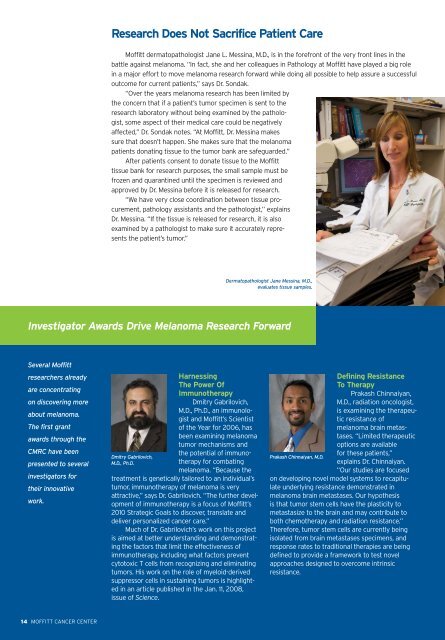Annual Report 2007 3-24-08.pdf - Moffitt Cancer Center
Annual Report 2007 3-24-08.pdf - Moffitt Cancer Center
Annual Report 2007 3-24-08.pdf - Moffitt Cancer Center
Create successful ePaper yourself
Turn your PDF publications into a flip-book with our unique Google optimized e-Paper software.
Research Does Not Sacrifice Patient Care<br />
<strong>Moffitt</strong> dermatopathologist Jane L. Messina, M.D., is in the forefront of the very front lines in the<br />
battle against melanoma. “In fact, she and her colleagues in Pathology at <strong>Moffitt</strong> have played a big role<br />
in a major effort to move melanoma research forward while doing all possible to help assure a successful<br />
outcome for current patients,” says Dr. Sondak.<br />
“Over the years melanoma research has been limited by<br />
the concern that if a patient’s tumor specimen is sent to the<br />
research laboratory without being examined by the pathologist,<br />
some aspect of their medical care could be negatively<br />
affected,” Dr. Sondak notes. “At <strong>Moffitt</strong>, Dr. Messina makes<br />
sure that doesn’t happen. She makes sure that the melanoma<br />
patients donating tissue to the tumor bank are safeguarded.”<br />
After patients consent to donate tissue to the <strong>Moffitt</strong><br />
tissue bank for research purposes, the small sample must be<br />
frozen and quarantined until the specimen is reviewed and<br />
approved by Dr. Messina before it is released for research.<br />
“We have very close coordination between tissue procurement,<br />
pathology assistants and the pathologist,” explains<br />
Dr. Messina. “If the tissue is released for research, it is also<br />
examined by a pathologist to make sure it accurately represents<br />
the patient’s tumor.”<br />
Dermatopathologist Jane Messina, M.D.,<br />
evaluates tissue samples.<br />
Investigator Awards Drive Melanoma Research Forward<br />
Several <strong>Moffitt</strong><br />
researchers already<br />
are concentrating<br />
on discovering more<br />
about melanoma.<br />
The first grant<br />
awards through the<br />
CMRC have been<br />
presented to several<br />
investigators for<br />
their innovative<br />
work.<br />
Dmitry Gabrilovich,<br />
M.D., Ph.D.<br />
Harnessing<br />
The Power Of<br />
Immunotherapy<br />
Dmitry Gabrilovich,<br />
M.D., Ph.D., an immunologist<br />
and <strong>Moffitt</strong>’s Scientist<br />
of the Year for 2006, has<br />
been examining melanoma<br />
tumor mechanisms and<br />
the potential of immunotherapy<br />
for combating<br />
melanoma. “Because the<br />
treatment is genetically tailored to an individual’s<br />
tumor, immunotherapy of melanoma is very<br />
attractive,” says Dr. Gabrilovich. “The further development<br />
of immunotherapy is a focus of <strong>Moffitt</strong>’s<br />
2010 Strategic Goals to discover, translate and<br />
deliver personalized cancer care.”<br />
Much of Dr. Gabrilovich’s work on this project<br />
is aimed at better understanding and demonstrating<br />
the factors that limit the effectiveness of<br />
immunotherapy, including what factors prevent<br />
cytotoxic T cells from recognizing and eliminating<br />
tumors. His work on the role of myeloid-derived<br />
suppressor cells in sustaining tumors is highlighted<br />
in an article published in the Jan. 11, 2008,<br />
issue of Science.<br />
Defining Resistance<br />
To Therapy<br />
Prakash Chinnaiyan,<br />
M.D., radiation oncologist,<br />
is examining the therapeutic<br />
resistance of<br />
melanoma brain metastases.<br />
“Limited therapeutic<br />
options are available<br />
for these patients,”<br />
Prakash Chinnaiyan, M.D.<br />
explains Dr. Chinnaiyan.<br />
“Our studies are focused<br />
on developing novel model systems to recapitulate<br />
underlying resistance demonstrated in<br />
melanoma brain metastases. Our hypothesis<br />
is that tumor stem cells have the plasticity to<br />
metastasize to the brain and may contribute to<br />
both chemotherapy and radiation resistance.”<br />
Therefore, tumor stem cells are currently being<br />
isolated from brain metastases specimens, and<br />
response rates to traditional therapies are being<br />
defined to provide a framework to test novel<br />
approaches designed to overcome intrinsic<br />
resistance.<br />
14 MOFFITT CANCER CENTER








